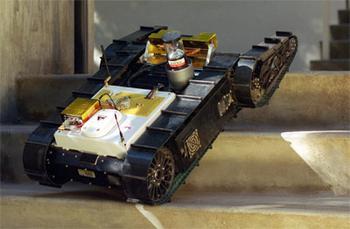Sensors Drive the Role of the Robot Industry
 With the development of automation and intelligence, robots have become more and more widely used in the industry and their status has become increasingly important. Robots incorporating technologies in various fields such as machinery, electronics, sensors, computers, artificial intelligence, etc., have increasingly become the favorable support for the development of the intelligent manufacturing equipment industry.
With the development of automation and intelligence, robots have become more and more widely used in the industry and their status has become increasingly important. Robots incorporating technologies in various fields such as machinery, electronics, sensors, computers, artificial intelligence, etc., have increasingly become the favorable support for the development of the intelligent manufacturing equipment industry. Sensors have contributed to the rapid and orderly development of the robotics industry. The sensor is used to detect the robot's own working status, and the robot's intelligent detection of the external working environment and the status of the object's core components. A device or device that can sense the prescribed measurements and convert it into usable output signals in accordance with certain laws.
In order to achieve autonomy in complex, dynamic, and uncertain environments, researchers from various countries have gradually combined various sensors with different functions such as vision, hearing, pressure sensing, thermal sensation, and force sensor to form a robot. The sensory system provides the robot with more detailed information about the external environment, which in turn enables the robot to respond to changes in the external environment in real time, accurately, and flexibly.
Today, many types of sensors, such as touch sensors, vision sensors, tilt sensors (or tilt modules), force sensors, perceptual sensors, ultrasonic sensors, and auditory sensors, have been widely applied to robots. These sensors make the robot more sensory, enabling more complex analysis and better completion of work, greatly improving the robot's working conditions.
The tactile sensor is a first-class modern sensor. This type of sensor can provide on-site monitoring of gripping forces and surfaces. Therefore, it can hold the object with high sensitivity while recognizing the object. Tactile sensors can help reliably and safely handle fragile components of different geometries. They can also place and connect changing objects. In the future, touch sensors will play an increasingly important role in the field of service robots. They turn grippers into agile assistants that can be efficiently used in complex and disorderly environments.
At present, the most versatile torque sensor for industrial automation measures power and time in all six degrees of freedom. The sixth axis is equipped with a robot control interface, so the connection is greatly simplified. The high-precision sensor outputs data at a high speed of 7000Hz, follows five communication protocols (Ethernet, Ethernet/IP, DeviceNet, Profinet, and a CAN-Bus interface), realizes remote control via LAN, and has unique interface compatibility. Configure via web interface. It can be applied to product testing, robot assembly, processing tasks such as grinding and polishing, robotic surgery, and other areas of rehabilitation and neurology. The sensor also supports a highly dynamic concept of control and can therefore be used to automate complex assembly, processing and completion of tasks that were previously performed manually or with complex special machines.
At present, there are still difficulties in the systematization of multi-sensor information fusion, and there is no theoretical basis. The ideal target for multi-sensor information fusion should be human perception, recognition, and control system. However, because there is no clear engineering explanation for the latter, what kind of function the robot sensor fusion system should have is still a vague concept. . It is believed that with the improvement of the level of robot intelligence, multi-sensor information fusion theory and technology will gradually improve and systematize.
Our titanium sheets are the epitome of excellence, offering exceptional properties and versatile applications.
Manufactured using the highest quality titanium available, our sheets boast remarkable strength, low density, and outstanding corrosion resistance. This combination of attributes ensures their longevity and reliability in even the most demanding environments.
One of the key advantages of our titanium sheets is their exceptional strength-to-weight ratio. Despite their impressive strength, these sheets remain lightweight, making them an ideal choice for industries where weight reduction is critical. From aerospace and automotive to sporting goods manufacturing, our titanium sheets provide the strength required without compromising on weight.
Corrosion resistance is another standout feature of our titanium sheets. They can withstand exposure to corrosive chemicals, seawater, and extreme temperatures, making them highly durable and reducing maintenance costs over time. This exceptional resistance to corrosion is a valuable asset in industries where protection against environmental factors is crucial.
Our titanium sheets also exhibit excellent formability, allowing for easy shaping, bending, and forming to meet specific requirements. This versatility opens up a world of possibilities for designers and engineers, enabling them to create innovative and customized solutions across various manufacturing processes.
The applications of our titanium sheets span a wide range of industries. In the aerospace and aviation sectors, these sheets find use in aircraft components, including wings, fuselage panels, and engine parts. The medical field benefits from their presence in surgical implants, prosthetics, and medical instruments. Additionally, industries such as chemical processing, marine, and energy rely on our titanium sheets for their exceptional properties.
Titanium Sheet,3Mm Titanium Sheet,Titanium Alloy Plate,Titanium Alloy Sheet
Yesino Metal Co., Ltd , https://www.yesinometal.com